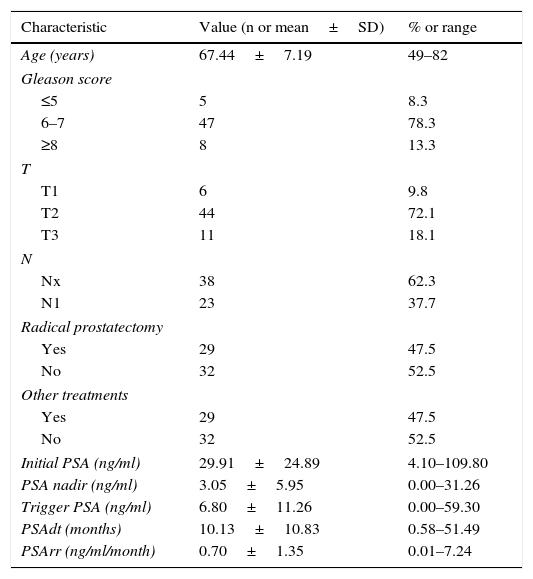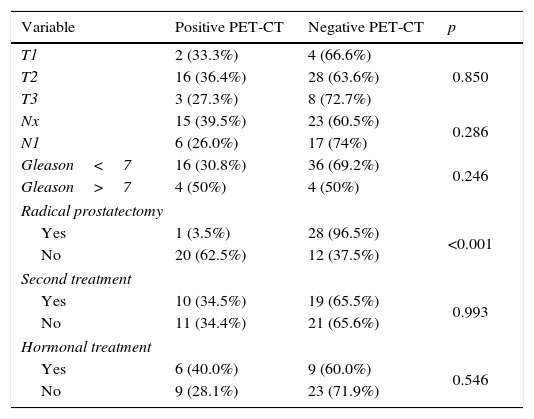To analyze the ability of the PET-CT with 18F-fluorocholine (18F-FCH) to detect disease on biochemical recurrence after treatment with curative intent. To determine the clinical variables that would be able to optimize the test's diagnostic yield.
Material and methodsA retrospective study of PET-CTs with 18F-fluorocholine performed on 61 patients with prostate cancer who had undergone treatment with curative intent and met the criteria for biochemical recurrence. The results of the PET-CT were categorized into positive or negative and were validated using pre-established criteria. The relationship between the result of the PET-CT and the initial PSA nadir, PSA trigger, rising PSA velocity (PSAva) and PSA doubling time (PSAdt). The relationship between the metastatic sites on the PET-CT and the remaining variables was analyzed.
ResultsThere was a 34.4% detection rate of the disease. The initial PSA, PSA nadir, PSA trigger and PSAva showed statistically significant differences according to the result of the PET-CT. The best discriminatory cut-off point between a positive or negative PET-CT for PSA trigger and PSAva was 3.5ng/ml and 0.25ng/ml/month respectively. The PSAdt was significantly lower in patients with remote disease compared to patients with localized disease (5.1 vs 16.8 months, p=0.01). The probability that the PET-CT would detect remote disease vs localized disease was 3.2 times higher if the PSAdt was under 6 months (80% vs 20%, OR: 3.2, p=0.02). In the multivariate analysis, only the initial PSA and not having undergone radical prostatectomy were demonstrated as independent predictive factors of a positive PET-CT result.
ConclusionsThe PET-CT with 18F-FCH can detect disease in a high percentage of patients with biochemical recurrence and provides information on its anatomical location. PSA kinetics and the patient's previous treatment are key variables in increasing the test's diagnostic.
Analizar la capacidad de la PET-TC con 18F-fluorocolina (18F-FCH) para detectar enfermedad en el momento de la recidiva bioquímica tras tratamiento con intención curativa. Determinar qué variables clínicas serían capaces de optimizar la rentabilidad diagnóstica de la prueba.
Material y métodosEstudio retrospectivo de las PET-TC con 18F-FCH realizadas a 61 pacientes con cáncer de próstata sometidos a tratamiento con intención curativa y que cumplían criterios de recidiva bioquímica. Los resultados del estudio PET-TC se categorizaron en positivos o negativos y fueron validados según criterios preestablecidos. Se estudió la relación entre el resultado de la PET-TC y el PSA inicial, PSA nadir, PSA trigger, velocidad de ascenso del PSA (PSAva) y PSA doubling time (PSAdt). Se analizó la relación entre las localizaciones metastásicas en la PET-TC y el resto de variables.
ResultadosLa tasa de detección de enfermedad fue del 34,4%. El PSA inicial, el PSA nadir, el PSA trigger y el PSAva demostraron diferencias estadísticamente significativas según el resultado de la PET-TC. El mejor punto de corte discriminatorio entre una PET-TC positiva o negativa para el PSA trigger y la PSAva fue 3,5ng/ml y 0,25ng/ml/mes respectivamente. El PSAdt fue significativamente menor en los pacientes con enfermedad a distancia frente a los pacientes con enfermedad localizada (5.1 vs 16.8 meses, p=0.01). La probabilidad de que la PET-TC detectara enfermedad a distancia vs localizada fue 3,2 veces mayor si el PSAdt era menor de 6 meses (80% vs 20%, OR: 3,2, p=0,02). En el análisis multivariante solo el PSA inicial y el hecho de no haberse sometido a prostatectomía radical demostraron ser factores predictores independientes del resultado positivo de la PET-TC.
ConclusionesLa PET-TC con 18F-FCH es capaz de detectar enfermedad en un alto porcentaje de pacientes con recidiva bioquímica, y proporciona información sobre la localización anatómica de la misma. La cinética del PSA y el tratamiento previo del paciente son variables clave para aumentar el rendimiento diagnóstico de la exploración.












